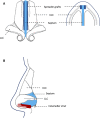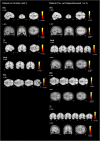Functional septorhinoplasty alters brain structure and function: Neuroanatomical correlates of olfactory dysfunction
- PMID: 37089704
- PMCID: PMC10117949
- DOI: 10.3389/falgy.2023.1079945
Functional septorhinoplasty alters brain structure and function: Neuroanatomical correlates of olfactory dysfunction
Abstract
Introduction: We previously demonstrated functionally significant structural plasticity within the central olfactory networks, in association with improved olfaction after surgical treatment of chronic rhinosinusitis (CRS). In order to confirm and expand on these findings, the primary aim of this study was to determine whether these same regions undergo functionally significant structural plasticity following functional septorhinoplasty (fSRP), in patients with non-CRS olfactory dysfunction (OD) of mixed cause. fSRP has previously been shown to improve olfactory function, and the secondary aim of this study was to provide initial insights into the mechanism by which fSRP affects olfaction.
Methods: We performed a pilot prospective, multimodal neuroimaging study in 20 participants undergoing fSRP, including patients with non-CRS OD of mixed cause, as well as normosmic surgical controls. Participants underwent psychophysical olfactory testing, assessment of nasal airway, structural and functional neuroimaging. This was performed pre- and postoperatively in patients, and preoperatively in controls.
Results: There was a statistically and clinically significant improvement in mean psychophysical olfactory scores after surgery. This was associated with structural and functional plasticity within areas of the central olfactory network (anterior cingulate, orbitofrontal cortex, insula, temporal pole). Improved psychophysical scores were significantly correlated with change in bilateral measures of nasal airflow, not measures of airflow symmetry, suggesting that improved overall airflow was more important than correction of septal deviation.
Conclusion: This work highlights the importance of these neuroanatomical regions as potential structural correlates of olfactory function and dysfunction. Our results also provide initial insight into the mechanistic effects of fSRP on olfaction. Further work could investigate the utility of these regions as personalised biomarkers of OD, as well as the role of fSRP in treating OD.
Keywords: cortical thickness; functional MRI; grey matter volume; olfaction; olfactory dysfunction; plasticity; septorhinoplasty; treatment.
© 2023 Whitcroft, Mancini, Yousry, Hummel and Andrews.
Conflict of interest statement
The authors declare that the research was conducted in the absence of any commercial or financial relationships that could be construed as a potential conflict of interest.
Figures





Similar articles
-
Sinonasal surgery alters brain structure and function: Neuroanatomical correlates of olfactory dysfunction.J Neurosci Res. 2021 Sep;99(9):2156-2171. doi: 10.1002/jnr.24897. Epub 2021 Jun 10. J Neurosci Res. 2021. PMID: 34110641 Clinical Trial.
-
The Effectiveness of Functional Septorhinoplasty in Improving COVID-19-related Olfactory Dysfunction.Facial Plast Surg. 2025 Feb 24. doi: 10.1055/a-2535-0153. Online ahead of print. Facial Plast Surg. 2025. PMID: 39929248
-
Structural Plasticity of the Primary and Secondary Olfactory cortices: Increased Gray Matter Volume Following Surgical Treatment for Chronic Rhinosinusitis.Neuroscience. 2018 Dec 15;395:22-34. doi: 10.1016/j.neuroscience.2018.10.011. Epub 2018 Oct 13. Neuroscience. 2018. PMID: 30326289
-
Magnetic Resonance Imaging as a Diagnostic and Research Tool in Patients with Olfactory Dysfunction: A Systematic Review.Am J Rhinol Allergy. 2022 Sep;36(5):668-683. doi: 10.1177/19458924221096913. Epub 2022 May 18. Am J Rhinol Allergy. 2022. PMID: 35585698
-
Olfactory Dysfunction and Chronic Rhinosinusitis.Immunol Allergy Clin North Am. 2020 May;40(2):223-232. doi: 10.1016/j.iac.2019.12.013. Epub 2020 Jan 16. Immunol Allergy Clin North Am. 2020. PMID: 32278447 Review.
Cited by
-
Mapping the Olfactory Brain: A Systematic Review of Structural and Functional Magnetic Resonance Imaging Changes Following COVID-19 Smell Loss.Brain Sci. 2025 Jun 27;15(7):690. doi: 10.3390/brainsci15070690. Brain Sci. 2025. PMID: 40722282 Free PMC article. Review.
-
Inflammation and olfactory loss are associated with at least 139 medical conditions.Front Mol Neurosci. 2024 Oct 11;17:1455418. doi: 10.3389/fnmol.2024.1455418. eCollection 2024. Front Mol Neurosci. 2024. PMID: 39464255 Free PMC article.
-
Correlation Between Cortical Thickness Abnormalities of the Olfactory Sulcus and Olfactory Identification Disorder and Persistent Auditory Verbal Hallucinations in Chinese Patients With Chronic Schizophrenia.Schizophr Bull. 2024 Aug 27;50(5):1232-1242. doi: 10.1093/schbul/sbae040. Schizophr Bull. 2024. PMID: 38577952 Free PMC article.
-
Objective and Subjective Outcomes Following Radiofrequency of Inferior Turbinates in Patients with Sleep-Disordered Breathing.Diagnostics (Basel). 2024 Aug 21;14(16):1820. doi: 10.3390/diagnostics14161820. Diagnostics (Basel). 2024. PMID: 39202311 Free PMC article.
References
LinkOut - more resources
Full Text Sources

